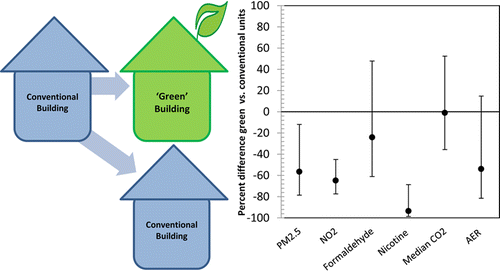'Green buildings' have potential to improve health of low-income housing residents

The "green building" trend is often associated with helping the environment by using eco-friendly materials and energy-saving techniques, but these practices are designed to improve people's health, too. Now scientists are reporting evidence that they can indeed help people feel better, including those living in low-income housing. Published in ACS' journal Environmental Science & Technology, the study found that certain health problems of public housing residents who moved into green buildings noticeably improved.
Gary Adamkiewicz, Meryl Colton and colleagues note that indoor air quality is an important predictor of health, especially among low-income populations. Adults in the U.S. spend most of their time indoors—65 percent of their time is spent in their homes. But indoor air pollutants, including particulate matter, nitrogen dioxide, tobacco smoke and other compounds can exacerbate respiratory problems such as asthma or even lead to cancer. In low-income communities, poorly maintained housing and locations close to industrial zones can worsen indoor air quality. Green housing, which is designed to be environmentally friendly, is also meant to improve inside air. But few studies have measured what the green building standards mean for people's health. Adamkiewicz's team wanted to find out.
A chance to do so came up in 2011. As part of its efforts to improve housing conditions for residents across the city, the Boston Housing Authority started redeveloping several buildings using green design features. These include switching from gas to electric stoves and prohibiting indoor smoking. In these buildings, the researchers found significantly lower levels of particulate matter, nitrogen dioxide and nicotine than in older buildings. Residents in green homes reported 47 percent fewer "sick building syndrome" symptoms, including headaches and itchy or burning eyes, that are commonly linked to indoor air pollution. "This work builds on more than 10 years of work in public housing and highlights an important opportunity to improve health in low-income communities on a large scale," the researchers say.
More information: Indoor Air Quality in Green vs. Conventional Multi-Family Low-Income Housing, Environ. Sci. Technol., Article ASAP. DOI: 10.1021/es501489u
Abstract
Indoor air quality is an important predictor of health, especially in low-income populations. It is unclear how recent trends in "green" building affect the indoor exposure profile. In two successive years, we conducted environmental sampling, home inspections, and health questionnaires with families in green and conventional (control) apartments in two public housing developments. A subset of participants was followed as they moved from conventional to green or conventional to conventional housing. We measured particulate matter less than 2.5 μm aerodynamic diameter (PM2.5), formaldehyde, nitrogen dioxide (NO2), nicotine, carbon dioxide (CO2), and air exchange rate (AER) over a seven-day sampling period coincident with survey administration. In multivariate models, we observed 57%, 65%, and 93% lower concentrations of PM2.5, NO2, and nicotine (respectively) in green vs control homes (p = 0.032, p < 0.001, p = 0.003, respectively), as well as fewer reports of mold, pests, inadequate ventilation, and stuffiness. Differences in formaldehyde and CO2 were not statistically significant. AER was marginally lower in green buildings (p = 0.109). Participants in green homes experienced 47% fewer sick building syndrome symptoms (p < 0.010). We observed significant decreases in multiple indoor exposures and improved health outcomes among participants who moved into green housing, suggesting multilevel housing interventions have the potential to improve long-term resident health.
Journal information: Environmental Science & Technology
Provided by American Chemical Society















